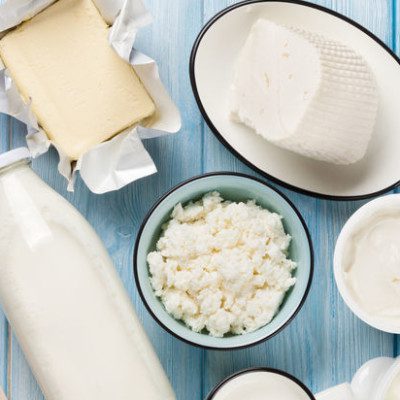Origin
Dairy products have been consumed by humans for nutrition since ancient times, as early as 8000 BCE.3
Cultured dairy products have an ancient history that dates back to Mesopotamian times. Yogurt is thought to have been discovered by accident, when milk with a naturally occurring enzyme was left for hours to ferment.3
Today, these products are a fundamental part of human diet, and food formulations. 1,2
Function
Following is a brief summary of the common functions of different dairy products:1
| Dairy Product | Function |
|---|---|
| Milk |
|
| Butter |
|
| Cream |
|
| Dry Milk Solids |
|
| Yogurt |
|
| Buttermilk |
|
Nutrition
These products are considered one of the five main food groups for human diet. The USDA recommends the consumption of 2 – 3 servings of dairy products a day.3 These foods are a good source of minerals, in particular calcium; as well as a good source of vitamins B12, B6, A and D.3
Saturated fats in dairy products have been associated with increased risk of heart disease, diabetes, and other chronic diseases.3 Similarly, the lactose component in dairy products presents a challenge to individuals with lactose intolerance, a digestive disorder that may cause bloating, diarrhea and other digestive issues. 1,3
Application
Dairy products are used in most baking formulations to provide a wide variety of essential functions including:1,2
| Dairy Product | Baked Good | Benefits |
|---|---|---|
| Butter | Cakes, cookies, muffins, brownies, puff pastry, croissants, ect. |
|
| Milk | Cakes, puff pastry, muffins, custards |
|
| Cream | Cakes, filling pastries, topping in cakes |
|
| Dry Milk Solids | Bread, cakes, muffins and cookies.
Not recommended for custards and creams |
|
| Yogurt | Cakes, muffins |
|
| Buttermilk | Cakes, biscuits |
|
Regulations
Dairy products are generally recognized as safe by the FDA when following good manufacturing practices. However, lactose found in dairy products is a commonly known food allergen, and consumers must take the appropriate precautions when consuming it.4
Dairy products are regulated by CFR Title 21 Part 131 Milk and Cream by the FDA. 4
In the EU, dairy products are regulated by several EU Commission documents, including Regulation (EC) No 178/2002, 852/2004, 854/2004 and 882/2004 that establishes the base of health rules for trade in Europe.5
References
- Figoni, P. How Baking Works: Exploring The Fundamentals Of Baking Science. 2nd ed., John Wiley & Sons, Inc., 2008.
- Chandan, Ramesh C. “Dairy ingredients for food processing: an overview.” Dairy ingredients for food processing (2011): 3-33.
- Miller, Gregory D., Judith K. Jarvis, and Lois D. McBean. Handbook of dairy foods and nutrition. CRC press, 2006.
- Food and Drug Administration (FDA). US Department of Health and Human Services. CFR Code of Federal Regulations Title 21, Part 131 Milk and Cream ,https://www.accessdata.fda.gov/scripts/cdrh/cfdocs/cfcfr/CFRSearch.cfm?CFRPart=131&showFR=1 , Accessed 28 November 2020.
- European Commission. “Milk & Milk Products – Food Safety – European Commission”. Food Safety – European Commission, 2020, https://ec.europa.eu/food/animals/animalproducts/milk_en#:~:text=The%20veterinary%20certificate%20is%20required,EU)%20No%20605%2F2010 . Accessed 28 Nov 2020.

